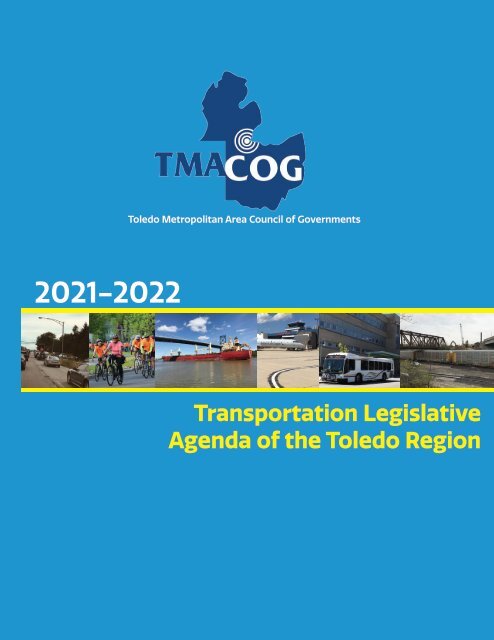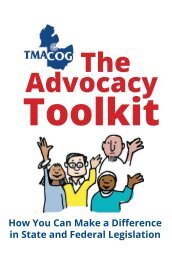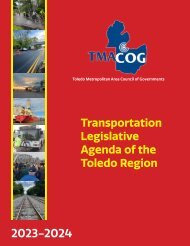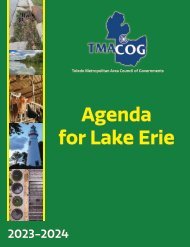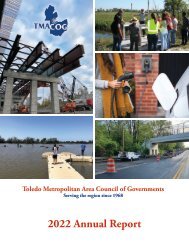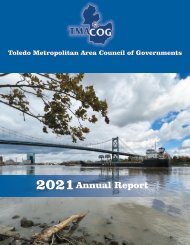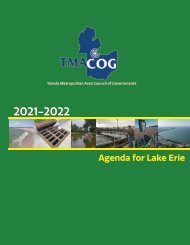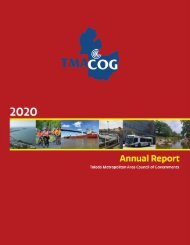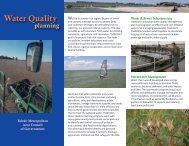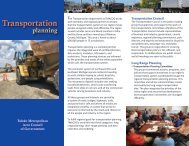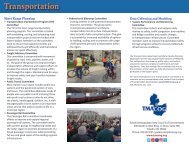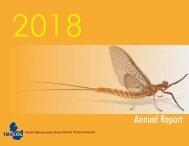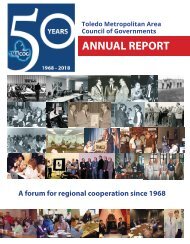2021-2022 TMACOG Transportation Legislative Agenda
2021-2022 TMACOG Transportation Legislative Agenda
2021-2022 TMACOG Transportation Legislative Agenda
You also want an ePaper? Increase the reach of your titles
YUMPU automatically turns print PDFs into web optimized ePapers that Google loves.
Toledo Metropolitan Area Council of Governments<br />
<strong>2021</strong>-<strong>2022</strong><br />
<strong>Transportation</strong> <strong>Legislative</strong><br />
<strong>Agenda</strong> of the Toledo Region
www.tmacog.org/transportation/legislative-agenda
Table of Contents<br />
<strong>Transportation</strong> <strong>Legislative</strong> <strong>Agenda</strong> Policy Briefs<br />
Page<br />
Federal <strong>Transportation</strong> Funding.........................................................................2<br />
State and Local <strong>Transportation</strong> Funding.............................................................3<br />
Air <strong>Transportation</strong>..............................................................................................4<br />
Autonomous and Connected Vehicles <strong>Transportation</strong>.......................................5<br />
Freight Rail.........................................................................................................6<br />
Logistics <strong>Transportation</strong>.....................................................................................7<br />
Marine <strong>Transportation</strong>.......................................................................................8<br />
Passenger Rail....................................................................................................9<br />
Pedestrian and Bikeways..................................................................................10<br />
Public <strong>Transportation</strong>.......................................................................................11<br />
Streets, Highways, and Bridges........................................................................12<br />
1.
Federal <strong>Transportation</strong> Funding Brief<br />
As the infrastructure funding gap continues to grow, prudent investments are needed now to prevent further deterioration<br />
of our streets, highways, bridges, rail and transit systems, pedestrian and bikeway systems, airports, seaports, and<br />
waterways. The public sector has a responsibility to act to improve safety, support quality of life, increase employment<br />
opportunities, and enhance economic competitiveness. The strategies and recommendations included in the Toledo<br />
Region <strong>Transportation</strong> <strong>Legislative</strong> <strong>Agenda</strong> are the consensus view of the members of the <strong>Transportation</strong> Coalition.<br />
Consultative meetings held with coalition members between July 2020 and September 2020 produced a set of legislative<br />
policy recommendations and modal policy briefs for federal, state, and local leaders.<br />
FEDERAL Priorities<br />
• After 25 years of stagnation, increase the gas tax or pursue other reforms to ensure long-term solvency of the<br />
Highway Trust Fund. Support the ability of state and local governments to plan, fund, and construct the projects that<br />
will rebuild our infrastructure and strengthen our economy.<br />
• Prefer user taxes and fees such as the motor fuel tax and other fuels taxes, vehicle miles traveled fee, freight waybill<br />
tax, shipping container fees, impact fees, tolling, and similar strategies. Design these fees with attention to the fee<br />
per unit, the means to adjust the fee over time (such as linking to Consumer Price Index), administrative costs, and<br />
privacy safeguards.<br />
• Where appropriate, attract private capital via public-private partnerships that feature transparent agreements and<br />
accountability through tightly monitored performance standards.<br />
• Support changes to federal tax law to enable private individuals and corporations to contribute to construction and<br />
maintenance of public infrastructure on a tax-deductible basis. Retain the tax-exempt status of municipal bonds<br />
(i.e., governmental bonds and private activity bonds) in order to support lower borrowing costs for locally developed<br />
infrastructure projects.<br />
• Leverage public funds and encourage private co-investment via credit assistance programs such as infrastructure<br />
banks, the <strong>Transportation</strong> Infrastructure Finance and Innovation Act, the Railroad Rehabilitation & Improvement<br />
Financing program, etc. Improve and broaden the feasibility of these and other innovative financing mechanisms by<br />
streamlining application timelines and requirements.<br />
• Support funding for intelligent transportation systems to improve the safety and efficiency of transport, such as<br />
connected and autonomous vehicle infrastructure and technology.<br />
• Implement a national strategic freight plan and improve flexibility to expend funds on airport, seaport, rail,<br />
intermodal, roads, highways, and other key freight investments.<br />
• Support the proposed 2020 update to the America’s Water Infrastructure Act. Maintain a regular, biannual process of<br />
authorizing projects and activities related to the key missions of the U.S. Army Corps of Engineers.<br />
• Support full use of the Harbor Maintenance Tax (HMT) revenue solutions and use HMT funds for intended purposes.<br />
Provide an exemption from the HMT for domestic and U.S.—Canadian movements for non-bulk cargo within the<br />
Great Lakes and St. Lawrence Seaway System.<br />
• Equitably fund all modes of transportation including increasing the share allocated to public transportation (Mass<br />
Transit Account), active transportation (the <strong>Transportation</strong> Alternatives Program), and passenger rail.<br />
• Appropriate passenger rail funding as authorized in the FAST Act and include adequate funding for passenger rail,<br />
including long distance routes in future legislation.<br />
• Continue subsidizing transportation out of general treasury funds until a permanent solution to the infrastructure<br />
funding gap is implemented.<br />
• Support the continuation of COVID-19 relief funding to assist operations of airports, seaports, and public transit<br />
agencies.<br />
• Support continuation of the U.S. Maritime Administration’s Port Infrastructure Development Program.<br />
• Establish and provide initial funding for a National Infrastructure Bank which would provide direct loans for<br />
qualifying infrastructure projects across the nation.<br />
2.
<strong>Transportation</strong> <strong>Legislative</strong> <strong>Agenda</strong> of the Toledo Region [<strong>2021</strong>-<strong>2022</strong>]<br />
State and Local <strong>Transportation</strong> Funding Policy Brief<br />
State and Local <strong>Transportation</strong> Funding Policy Brief<br />
As the infrastructure funding gap grows, prudent investments are needed now to prevent further deterioration of our streets,<br />
highways, bridges, rail and transit systems, pedestrian and bikeway systems, airports, seaports, and waterways. The public<br />
sector has a responsibility to act to improve safety, support quality of life, increase employment opportunities, and enhance<br />
economic competitiveness. The strategies and recommendations included in the Toledo Region <strong>Transportation</strong> <strong>Legislative</strong><br />
<strong>Agenda</strong> are the consensus view of the members of the <strong>Transportation</strong> Coalition. Consultative meetings held with coalition<br />
members between July 2020 and September 2020 produced a set of legislative policy recommendations and modal policy<br />
briefs for federal, state, and local leaders.<br />
STATE Priorities<br />
• In the absence of increased federal funding, Ohio must take state-level action to deliver locally identified projects by<br />
increasing existing revenue sources and developing new sources. Equitably fund all modes of transportation including<br />
increasing the share allocated to public transportation, railways, seaports, airports, and active transportation.<br />
• To prevent further erosion in purchasing power of the revenue from Ohio’s flat rate per gallon motor fuel excise tax,<br />
consider indexing some or all the tax. Among the other options for indexing are the Consumer Price Index, the average<br />
wholesale price of fuel, and the Producer Price Index.<br />
• Due to increasing vehicle fuel efficiency and the growing use of alternative fuels, Ohio should consider implementing a<br />
vehicle miles traveled user fee to counteract declining revenue from traditional sources.<br />
• Continue to allow localities to impose local option taxes, such as by supporting the indexing of Ohio’s base vehicle license<br />
plate fee and allowing counties and municipalities to enact and index permissive use plate fees.<br />
• Regarding the Ohio Turnpike, keep toll rate increases to a minimum. Use toll-generated revenue primarily to preserve and<br />
expand the turnpike itself. Distributions of bonds backed by toll revenue should stay within jurisdictions closest in<br />
geographic proximity to the turnpike, should produce a net gain in transportation dollars for those jurisdictions, and<br />
should be limited to infrastructure projects with a lifespan consistent with the terms of funding.<br />
• Implement the recommendations of ODOT’s Ohio Airports Focus Study.<br />
• Support continuation of the ODOT Maritime Assistance Program which provides infrastructure grants to eligible Ohio port<br />
authorities.<br />
• Support the new JobsOhio program to continue to help Ohio’s airports to attract new flights to unserved or underserved<br />
markets.<br />
• Continue programs such as the Ohio Bridge Partnership Program, the Clean Ohio Program, the State Capital<br />
Improvements Program, and Local <strong>Transportation</strong> Improvements Program.<br />
• Assist municipalities with full funding for resurfacing and reconstruction on U.S. and state routes within their jurisdiction<br />
by expanding ODOT’s Urban Paving Program and creating other options.<br />
• Support funding for intelligent transportation systems to improve the safety and efficiency of transport, such as<br />
connected and autonomous vehicle infrastructure and technology.<br />
• Support the Governor’s Highway Safety funding initiative and advocate for full funding of the Highway Safety<br />
Improvement Program (HSIP) rather than the current 20% local match requirement.<br />
• Continue to enhance programs under the Ohio Public Works Commission including the Local <strong>Transportation</strong> Improvement<br />
Program and the State Capital Improvement Program.<br />
LOCAL Priorities<br />
• Explore expanding use and funding of specially designated <strong>Transportation</strong> Improvement Districts (TIDs) such as those in<br />
Wood and Lucas counties.<br />
• Support efforts to fund and operate a truly regional, seamless public transit system to serve all the greater Toledo<br />
metropolitan area including all of Lucas County. Provide cost-effective access to surrounding counties and connections to<br />
and between cities in the region.<br />
• Local communities should consider utilizing all funding opportunities including the permissive license plate fees.<br />
• Support an increase in funds to local governments to address safety on local and municipal roads.<br />
Date as of 10/2020<br />
https://tmacog.org/transportation/legislative-agenda<br />
3.
<strong>Transportation</strong> <strong>Legislative</strong> <strong>Agenda</strong> of the Toledo Region [<strong>2021</strong>-<strong>2022</strong>]<br />
Air <strong>Transportation</strong> Policy Brief<br />
Air <strong>Transportation</strong> Policy Brief<br />
FEDERAL Priorities<br />
• Support with funding, regulatory clearances, etc., the recommendations of the Airport Master Plan for Eugene F.<br />
Kranz Toledo Express Airport as updated by the Toledo-Lucas County Port Authority.<br />
• Support efforts to preserve and modernize the infrastructure assets of the Ohio Air National Guard’s 180th<br />
Fighter Wing at TOL. Continue to invest in the Air Guard Ready Alert Mission to continue to build permanent<br />
hangars.<br />
• Support establishment of low-cost wetlands banking for public projects to allow mitigation of wetlands on a<br />
watershed basis rather than parcel-by-parcel.<br />
• Continued federal funding to support air service and cities during COVID-19 and reduced travels due to the<br />
public health emergency.<br />
• Promote the safe use of unmanned aircraft systems (UAS) commonly known as drones.<br />
• Support continuation of the Small Communities Air Service Development Program Grant.<br />
✓ While industry experts like Boeing estimate the aviation industry will need 637,000 commercial pilots and<br />
648,000 mechanics in the next 20 years, aviation training facilities in Ohio are reaching capacity.<br />
✓ Travel decline due to the COVID-19 pandemic, may take several years to fully return to normal.<br />
STATE Priorities<br />
• Implement the recommendations of ODOT’s Ohio Airports Focus Study.<br />
• Improve connectivity of airports to surface modes and improve connections to I-475 via US 20A.<br />
• Promote consistency between federal and state regulation of UAS. Prohibit drone use near critical infrastructure<br />
(specify trespass), and balance surveillance and privacy issues with opportunities for UAS economic<br />
development.<br />
• Reinvest a higher percentage of aviation-related tax revenue back into the Ohio Airport Grant Program.<br />
• Revise Ohio’s legislation to make all airports within the Ohio Airport System Plan eligible for grant funding.<br />
• Support funding for airfield infrastructure upgrades to maintain and enhance capabilities for passenger and<br />
cargo operations.<br />
• Develop a grant program and low-interest loan policies designed to support training for students entering<br />
aviation-related careers at Ohio universities and community colleges.<br />
• Support the new JobsOhio program to continue to help Ohio’s airports to attract new flights to unserved or<br />
underserved markets.<br />
LOCAL Priorities<br />
• Support efforts to increase leisure and business travel and attract more airlines to operate at Eugene F.<br />
Kranz Toledo Express Airport.<br />
REGIONAL Viewpoint<br />
• Aviation is critical to a balanced cargo and passenger system. Success of the air transport mode depends greatly<br />
upon reliable connectivity to regional road and railways and upon preserving and maintaining airport<br />
infrastructure. The airport division of the Toledo-Lucas County Port Authority operates the City of Toledo’s two<br />
airports—Eugene F. Kranz Toledo Express Airport and Toledo Executive Airport. These airports support five<br />
major areas of aviation operations: passenger, cargo, general aviation, military, and aviation education and<br />
training. Each operational area is important to the economic vitality of the airports and the northwest Ohio<br />
region.<br />
Date as of 10/2020<br />
4.<br />
https://tmacog.org/transportation/legislative-agenda
<strong>Transportation</strong> <strong>Legislative</strong> <strong>Agenda</strong> of the Toledo Region [<strong>2021</strong>-<strong>2022</strong>]<br />
Autonomous and Connected Vehicles <strong>Transportation</strong> Policy Brief<br />
Autonomous and Connected Vehicles <strong>Transportation</strong> Policy Brief<br />
An autonomous car is a vehicle capable of sensing its environment and operating without human involvement. The Society<br />
of Automotive Engineers (SAE) currently defines 6 levels of driving automation ranging from Level 0 (fully manual) to Level<br />
5 (fully autonomous). These levels have been adopted by the U.S. Department of <strong>Transportation</strong>.<br />
Connected vehicles combine advanced technology (advanced wireless communications, on-board computer processing,<br />
advanced vehicle-sensors, GPS navigation, smart infrastructure, and others) giving vehicles the ability to identify threats<br />
and hazards on the roadway and communicate this information over wireless networks to give drivers alerts and warnings.<br />
FEDERAL Priorities<br />
• Create a standards committee comprised of industry, technology, education, and government partners to<br />
develop codes and guidelines for interoperability and secure data communication.<br />
• Develop standards for cybersecurity and regulate the data collected by autonomous vehicles to preserve the<br />
privacy of vehicle owners and users (i.e., location data that can give away sensitive health-related information).<br />
• Adopt the standardized naming for advanced driver assistance technology created and updated by AAA,<br />
Consumer Reports, J.D. Power, and the National Safety Council.<br />
• Engage with all stakeholders to develop for adoption legislative policies for autonomous vehicles related to<br />
certification, licensing, training, and tort liability.<br />
• Establish Federal Transit Administration policies and procedures that permit the use of Congestion Mitigation<br />
and Air Quality (CMAQ) funding to support connected and/or autonomous vehicle projects.<br />
• Develop standards and guidelines to ensure public autonomous vehicles are ADA accessible.<br />
STATE Priorities<br />
• Establish a source of grant funds to support local autonomous and connected vehicle projects.<br />
• Support infrastructure improvements that support increased adoption and deployment of alternative fuel<br />
vehicles, including electric, compressed natural gas, and hydrogen fuel cell technologies.<br />
• Utilize highway right-of-way assets to improve digital communications infrastructure, particularly in rural areas<br />
of Ohio and Michigan, to close broadband and cellular infrastructure gaps.<br />
• Improve technology supporting transportation infrastructure across Ohio and Michigan including clear<br />
pavement markings and roadside communication units that support the deployment and testing of vehicle<br />
technologies.<br />
• Ensure that, if states require a license to operate an automated vehicle, persons with disabilities cannot be<br />
excluded from getting a license based on their disability.<br />
LOCAL Priorities<br />
• Establish a network of Level 2 and DC Fast Charge stations to facilitate the broader deployment of all-electric<br />
and hybrid vehicles.<br />
• Develop local policies for the operation of slow-moving autonomous vehicles in urban areas, prioritizing ease of<br />
movement for pedestrians and bicyclists.<br />
• Support ongoing and future efforts in Ohio and Michigan to create a seamless transportation technology<br />
deployment strategy between states.<br />
Date as of 10/2020<br />
https://tmacog.org/transportation/legislative-agenda<br />
5.
<strong>Transportation</strong> <strong>Legislative</strong> <strong>Agenda</strong> of the Toledo Region [<strong>2021</strong>-<strong>2022</strong>]<br />
Freight Rail Policy Brief<br />
FEDERAL Priorities<br />
• Support rail-oriented public-private partnerships to leverage available funding when addressing rail bottlenecks,<br />
modal conflicts, bridge rehabilitation, and other infrastructure needs.<br />
• Create a rail infrastructure trust fund for the public portion of partnerships with private rail companies.<br />
• Continue to provide federal grant programs such as the Consolidated Rail Infrastructure and Safety<br />
Improvements Program that provide funding for capital projects to improve passenger and freight rail<br />
transportation systems in terms of safety, efficiency, or reliability.<br />
STATE Priorities<br />
• Support maintaining and expanding short line and regional railroads by providing access to grants, loans and<br />
other assistance through the Ohio Rail Development Commission. Support funding to preserve the right-of-way<br />
of abandoned rail lines for future uses, including recreational use or future freight or passenger rail operations.<br />
• Address rail/highway crossing safety problems with funding for rail/highway grade separations, installation of<br />
four quadrant gate systems, improved crossing warning devices, or the elimination of redundant at-grade<br />
crossings.<br />
• Continue rail crossing diagnostic reviews at problem crossings to identify safety issues and decide the best<br />
course of action to ensure safe crossing for vehicles and pedestrians.<br />
• Invest in track improvements that eliminate freight and passenger conflicts and result in more efficient traffic<br />
flow for both freight and passenger rail.<br />
• Continue to produce and update as needed the Ohio Rail Plan as a tool for identifying freight and passenger rail<br />
investment opportunities, needed improvements, and for coordinating rail planning across the state.<br />
REGIONAL Priorities<br />
Freight Rail Policy Brief<br />
• Address rail and highway modal conflicts with grade separations where financially feasible or with alternative<br />
measures such as advance warning signs, signed alternate routes, or GPS navigation warnings.<br />
• Continue to improve the safety at rural at-grade rail crossings with lights and gates where needed.<br />
• Prevent vehicular traffic backups at busy urban rail crossings by using sensors and signal timing to control the<br />
flow of vehicles near crossings with stopped traffic.<br />
• Work with the railroads, local government, and with law enforcement to address the problem of re-occurring<br />
blockages of at-grade rail/highway crossings.<br />
• Work with railroads and communities to establish quiet zones where horns will not be sounded along track<br />
sections with one or more public at-grade crossings within the community.<br />
• Recognize the importance of short line and regional railroads and maintain and improve their connections to<br />
industrial sites, intermodal sites, and class 1 railroad interchanges.<br />
• Improve intermodal access and promote industry and warehouse development at the Norfolk Southern Toledo<br />
Intermodal Terminal and at the CSX Northwest Ohio Terminal, and other regional facilities.<br />
• Assure the maintenance of the aging Norfolk Southern, Wheeling & Lake Erie, and CSX rail swing bridges over<br />
the Maumee River to prevent disruptions in the flow of both rail and marine freight.<br />
• Support policies, communication, and coordination between railroads and public agencies to ensure the timely<br />
completion of infrastructure projects on or adjacent to railroad property.<br />
• Support and improve infrastructure to increase connectivity between rail and seaport infrastructure.<br />
• Work to resolve conflicts between railroads and adjacent landowners such as rail facility expansion, noise, air<br />
quality issues, cross-track accessibility, and safety issues.<br />
Date as of 10/2020<br />
6.<br />
https://tmacog.org/transportation/legislative-agenda
<strong>Transportation</strong> <strong>Legislative</strong> <strong>Agenda</strong> of the Toledo Region [<strong>2021</strong>-<strong>2022</strong>]<br />
Logistics <strong>Transportation</strong> Policy Brief<br />
Logistics <strong>Transportation</strong> Policy Brief<br />
FEDERAL Priorities<br />
• Improve connectivity between freight modes, freight facilities, and key industrial areas where freight-intensive<br />
activity is occurring or is planned.<br />
• Continue to implement the FAST Act freight programs such as developing a National Highway Freight Program<br />
that includes funding for Nationally Significant Freight and Highway Projects. Continue funding for the<br />
Infrastructure for Rebuilding America (INFRA) grants.<br />
• Support short-term relief and long-term incentives that address workforce needs across the supply chain<br />
including reasonable and safe hours of services and other regulations affecting the trucking industry.<br />
STATE Priorities<br />
• Review existing state laws and regulations for impediments to the safe testing and deployment of connected<br />
and automated vehicles including truck platooning and alternative fuels. Avoid creating a patchwork of<br />
inconsistent state laws by working with other states to standardize transport networks and support adoption of<br />
best practices.<br />
• Support the development and use of alternative fuels and clean, high-efficiency power plants in the trucking<br />
industry.<br />
• Promote design standards on truck routes that improve the safe flow of freight including truck-friendly<br />
intersections, ramps, turning width, turning radius, and signal timing. Ensure that signage on truck routes is<br />
unobscured, effectively spaced, and highly visible to commercial drivers.<br />
• Encourage cities to plan for non-constrictive truck access for urban freight delivery.<br />
• Provide efficient and reliable connections for industry by maintaining last mile connectors and using managed<br />
access along important freight corridors.<br />
• Eliminate rail/highway conflicts with grade separations, advance warning signs, or alternate routes. Work with<br />
railroads, local government, and law enforcement to address the problem of re-occurring blockages at at-grade<br />
crossings.<br />
• Expand commercial truck parking initiatives to provide adequate, legal, convenient, and safe parking areas for<br />
drivers with limited hours of service, overnight parking, or trucks waiting to deliver.<br />
• Leverage the region’s logistics assets in anticipation of the 2024 opening of the new 6-lane Gordie Howe<br />
International Bridge that will provide direct connection between I-75 and Canada’s Highway 401.<br />
• Support more parity between the gasoline tax and diesel tax. Currently, the Ohio motor fuel excise tax rate on<br />
diesel is 8.5 cents more per gallon than gasoline.<br />
• Encourage the allocation of additional funding sources to improve the availability of commercial vehicle parking<br />
across the state.<br />
LOCAL Priorities<br />
• Address the need for efficient truck connectors in Wood County between I-75 and Fostoria, and in Monroe<br />
County between US 23 and I-75.<br />
• Support development at Express Industrial Park by continuing to improve US 20A as an important freight<br />
corridor connecting Eugene F. Kranz Toledo Express Airport and I-475.<br />
• Use the region’s strategic location as an asset to develop facilities for trans-loading oil and gas products in a safe<br />
and efficient manner to support oil and gas production and refinement, and energy independence.<br />
• Support the initiatives of the Northwest Ohio / Southeast Michigan Comprehensive Economic Development<br />
Strategy (CEDS), a multi-county collaboration that leverages transportation assets and other regional<br />
competitive advantages to attract and retain jobs and investment in the region.<br />
• Address labor needs in the logistics industry through development and training of CDL drivers, vehicle<br />
mechanics, and technicians through high school and community college programs.<br />
Date as of 10/2020<br />
https://tmacog.org/transportation/legislative-agenda<br />
7.
<strong>Transportation</strong> <strong>Legislative</strong> <strong>Agenda</strong> of the Toledo Region [<strong>2021</strong>-<strong>2022</strong>]<br />
Marine <strong>Transportation</strong> Policy Brief<br />
Marine <strong>Transportation</strong> Policy Brief<br />
REGIONAL Viewpoint<br />
The Port of Toledo is a critical economic force. According to a 2018 study, Toledo’s port generated $669 million in<br />
economic activity, $513 million in personal income and local consumption expenditures, and $180 million in federal and<br />
state tax revenue.<br />
FEDERAL Priorities<br />
• Support and Implement America’s Water Infrastructure Act of 2020. Maintain a regular, biannual process of<br />
authorizing projects and activities related to the key missions of the U.S. Army Corps of Engineers.<br />
• Congress should require that all Harbor Maintenance Tax (HMT) revenue is spent for its intended purpose. The<br />
legislation should be perfected to ensure that Great Lakes ports receive no less than 10% of U.S. Army Corps of<br />
Engineers’ operation and maintenance funds each year.<br />
• Support HMT revenue solutions and use HMT funds for intended purposes. Provide an exemption from the HMT<br />
for domestic and U.S.—Canadian movements for non-bulk cargo within the Great Lakes and St. Lawrence<br />
Seaway System.<br />
• Congress should provide adequate funds in the FY <strong>2021</strong> Energy and Water Development Appropriations Bill to<br />
ensure continuation of the Soo Lock Asset Renewal Program and to ensure the flow of vital marine freight such<br />
as iron ore. U.S. Army Corps of Engineers began a multi-year Asset Renewal Program to rehabilitate and<br />
modernize the Soo Locks’ infrastructure at a total estimated cost of $181 million. The FY 2019 budget provided<br />
$2.4 million to rehabilitate the Soo Lock infrastructure; a shortfall of $20.99 million compared to the amount<br />
needed in FY 2019.<br />
• Support seaport-specific funding to modernize U.S. seaports including investments in technology and upgrades<br />
to the locks in the Saint Lawrence Seaway System.<br />
• Support the U.S. Army Corps of Engineers’ budget to appropriate funds for upland placement of dredge<br />
materials.<br />
• Establish a single federal ballast water rule by adopting standards put forth by the International Maritime<br />
Organization’s Convention for the Control and Management of Ship’s Ballast Water and Sediments.<br />
• Support continued funding for the Port Infrastructure Development Grant program and urge congress to include<br />
$500 million in the FY <strong>2021</strong> <strong>Transportation</strong> Appropriations bills.<br />
STATE Priorities<br />
• Support environmentally acceptable and financially feasible policies that enable short- and long-term<br />
management of dredged material including beneficial reuse, new capacity in existing confined disposal facilities,<br />
and/or safe disposal via policies previously identified.<br />
• Continue support for the Great Lakes Dredged Material Center for Innovation.<br />
• Provide reliable, long-term funding of the state’s maritime ports. Within the state biennial budget: allow for tax<br />
abatements for operating terminals located within harbors recognized by the state, offer non-local share state<br />
grants for port infrastructure, and continue to fund multimodal initiatives.<br />
• Support the ODOT Maritime Assistance Program.<br />
LOCAL Priorities<br />
• Support efforts to develop a major north/south and east/west maritime corridor for the City of Toledo.<br />
• Leverage the region’s strategic location for trans-loading oil, gas, and liquid bulk products in a safe and efficient<br />
manner to support oil and gas productions and refinement, and energy independence.<br />
• Assure appropriate infrastructure is in place to support maritime, rail, and trucking operations; specifically, local<br />
roadways and heavy haul routes.<br />
• Coordinate with the railroads to ensure the functionality and maintenance of aging swing bridge rail crossings<br />
over the Maumee River.<br />
8.<br />
Date as of 10/2020<br />
https://tmacog.org/transportation/legislative-agenda
<strong>Transportation</strong> <strong>Legislative</strong> <strong>Agenda</strong> of the Toledo Region [<strong>2021</strong>-<strong>2022</strong>]<br />
Passenger Rail Policy Brief<br />
Passenger Rail Policy Brief<br />
FEDERAL Priorities<br />
• Appropriate full funding for the rail programs at the amounts authorized by the FAST Act. These include<br />
programs for State of Good Repair ($140 million), Consolidated Rail Infrastructure and Safety Improvements,<br />
and passenger rail Restoration and Enhancements grants.<br />
• Support a viable national passenger rail system through multi-year funding for all Amtrak service, including long<br />
distance. Encourage short-line rail companies to compete for local passenger rail connections.<br />
• Support expansion of passenger rail service to five daily round trips in the Chicago-Toledo-New York corridor.<br />
• Implement a national strategic passenger rail plan that would improve passenger rail service and connections<br />
across the U.S.<br />
• Ensure ADA compliance on all passenger trains, platforms, and at all stations, and stress the importance of<br />
accessibility when funding passenger rail infrastructure projects.<br />
• Ensure the new Hyperloop technology is developed with ADA accessibility considerations.<br />
STATE Priorities<br />
• In addition to Amtrak, consider regional, short-line, or private sector passenger rail corridors to meet rail<br />
transportation needs.<br />
• Invest in station maintenance, upgrades, and intermodal connections to ensure reliable service and efficient<br />
access for rail passengers.<br />
• Invest in track improvements that eliminate both passenger and freight rail conflicts and result in more efficient<br />
traffic flow.<br />
• Study the feasibility of building a new Maumee River passenger and freight rail lift bridge near the Middle<br />
Grounds to replace or supplement the current aging swing bridge.<br />
• Support the Midwest Regional Rail Initiative that includes the Lake Shore Corridor from Chicago to Pennsylvania<br />
• Update the Ohio Hub plan with a new plan for implementing a statewide passenger rail system connecting<br />
major cities and regions across Ohio.<br />
• Support funding to preserve the right-of-way of abandoned rail lines for future uses, including recreational use<br />
or future freight or passenger rail operations.<br />
LOCAL Priorities<br />
• Support economic development of the Toledo train station area (Martin Luther King Jr. Plaza) by improving<br />
multimodal (motor vehicle, transit, bicycle, and pedestrian) connections to downtown Toledo as well as other<br />
parts of the city.<br />
• Continue to work with our regional partners to re-connect Toledo and Detroit by passenger rail, possibly by way<br />
of Detroit Metro Airport, and support connections to Monroe, Ann Arbor, and western and northern Michigan.<br />
• Study the feasibility of connecting Toledo by passenger rail south to Bowling Green, Findlay, and Columbus, and<br />
southwest to Fort Wayne, Indiana.<br />
• Address safety issues at rail crossings with rail/highway grade separations where feasible or with alternate<br />
measures such as four quadrant gate systems or closing of redundant at-grade crossings.<br />
• Support the development of light rail, street cars, trolley buses, or bus rapid transit as additional choices for<br />
connecting outlying areas to downtown and revisit the plan for developing a downtown circulator.<br />
• Maintain and upgrade as needed the Toledo train station (expansion and intermodal connections) in order to<br />
ensure continued service reliability and ADA compliance.<br />
• Advocate and encourage that, if developed, the Hyperloop stops in Toledo in order for the region to receive<br />
some of the economic benefits and provide additional public transportation options.<br />
Date as of 10/2020<br />
9.<br />
https://tmacog.org/transportation/legislative-agenda
Pedestrian and Bikeways Policy Brief<br />
Pedestrian and Bikeways Policy Brief<br />
FEDERAL Priorities<br />
• Support increased funding for the <strong>Transportation</strong> Alternatives (TA) program that addresses bikeways, pedestrian<br />
facilities, vegetation management, historic transportation facilities, environmental mitigation related to<br />
stormwater and habitat connectivity, and the Safe Routes to School program.<br />
STATE Priorities<br />
• Support creation and implementation of a statewide Complete Streets Policy.<br />
• Increase enforcement of the recently passed legislation requiring that Ohio motorists pass bicyclists leaving at<br />
least three feet of clearance via a multi-faceted education campaign targeting law enforcement, motorists, and<br />
bicyclists.<br />
• Continue and increase funding for Safe Routes to School programs and projects.<br />
• Support renewed funding of the Clean Ohio Fund program including the Trails Fund.<br />
• Support funding to plan and construct a signed network of bicycle-friendly street routes and multi-purpose<br />
paths that enable citizens to use bicycles as a practical means of transportation.<br />
• Support the following state plans: Active <strong>Transportation</strong> Safety Plan, Walk.Bike.Ohio Policy Plan, Ohio Trails<br />
Vision.<br />
• Modify the license plate code under ORC 4503.21 to include language to allow for an attachment to the rear of<br />
the vehicle of a tow ball, bicycle rack, removable hitch, or any other device designed to carry an object on the<br />
rear of a vehicle.<br />
LOCAL Priorities<br />
• Support implementation of the regional Complete Streets Policy and toolkit which includes the addition of<br />
pedestrian and bicycle facilities (bike lanes or paths) in roadway construction projects.<br />
• Encourage jurisdictions to adopt their own complete streets policies, resolutions, or ordinances.<br />
• Support implementation of the regional sidewalk policy. Enforce maintenance and snow removal policies on<br />
existing facilities and develop new facilities that address major barriers created by expressways, railroad tracks,<br />
and rivers.<br />
• Pursue Safe Routes to School initiatives to encourage lifelong health and safe personal mobility habits.<br />
• Support the usage and expansion of the ToleGO bikeshare program.<br />
• Support only licensed and responsible scooter-share companies and programs.<br />
✓ 9% of households in the <strong>TMACOG</strong> area do not have access to a vehicle.<br />
✓ Walking and bicycling improve environmental and personal health and can contribute to<br />
stronger local economies. Ohio currently ranks 18 th in the nation as a bicycle-friendly state.<br />
REGIONAL Viewpoint<br />
• A full range of mobility choices characterizes successful regions. Walking and bicycling are two methods of nonmotorized<br />
transportation that require infrastructure in the same way that automobiles require a network of<br />
roads, signs, and signals. Investments in sidewalks and on- and off-road bicycle facilities provide safe transport<br />
and support the same trip purposes as automobiles and transit. A safe, reliable, accessible, and multimodal<br />
network links employees to their places of employment and connects people of all abilities and ages to centers<br />
of commerce and to medical, educational, and recreational activities.<br />
Date as of 10/2020<br />
10.<br />
https://tmacog.org/transportation/legislative-agenda
<strong>Transportation</strong> <strong>Legislative</strong> <strong>Agenda</strong> of the Toledo Region [<strong>2021</strong>-<strong>2022</strong>]<br />
Public <strong>Transportation</strong> Policy Brief<br />
Public <strong>Transportation</strong> Policy Brief<br />
FUNDING Priorities<br />
• Support the extension of COVID-19 pandemic relief funding. Recovery from the economic hardships will continue for<br />
many years to come.<br />
• In 2000, the state of Ohio contributed $43.6 million in general revenue funds (GRF) to be distributed statewide to the<br />
61 transit systems in Ohio. Currently, the GRF allocation is $7.3 million.<br />
• Current transit funding per capita: Pennsylvania $128.83, Michigan $26.78, and Ohio $0.63. Ohio needs an increase in<br />
GRF for public transit.<br />
• Support efforts to fund and operate a truly regional, seamless public transit system to serve all the greater Toledo<br />
metropolitan area including all of Lucas County. Provide cost-effective access to surrounding counties and<br />
connections to and between major cities in the region.<br />
FEDERAL Priorities<br />
• Retain the federal Mass Transit Account (MTA) of the Highway Trust Fund and increase its revenues.<br />
• Incentivize cleaner, greener fleets and fund the replacement of existing diesel buses with environmentally<br />
sustainable, alternatively fueled vehicles.<br />
• Retain the transit commuter tax benefit at the same level as the parking tax benefit.<br />
• Retain the alternative fuels tax credit.<br />
• The Federal Transit Authority (FTA) should expedite the current federal grant approval process to speed project<br />
delivery and reduce costs of projects. This would include exempting routine activities (i.e., bus replacement,<br />
preventive maintenance and equipment) from the regional office approval process.<br />
STATE Priorities<br />
• Support the newly developed statewide long range plan, Access Ohio 2045.<br />
• Encourage ODOT to update the 2015 ODOT Ohio Statewide Transit Needs Study.<br />
• Double the General Revenue Fund contribution to ODOT Transit Funding.<br />
• Increase ODOT budget to fund half the 20% local match required for Transit Capital Projects. This commitment will<br />
ensure that critical capital projects are completed, and federal funds available are being spent in Ohio.<br />
• Expand the Ohio Department of Jobs and Family Services, Medicaid, and other funding sources for on-demand rides<br />
to address the transportation needs of individuals with disabilities, older adults, and people with low incomes.<br />
• Support the continuation of state funding programs to assist with capital and operational costs.<br />
LOCAL Priorities<br />
• Support the initiative for a county-wide public transit system.<br />
• Encourage the local transit agency to consider county-wide paratransit service by contracting and working with other<br />
providers.<br />
• Support implementation of locally developed Coordinated Public <strong>Transportation</strong> and Human Service <strong>Transportation</strong><br />
plans in Lucas and Wood counties to coordinate transportation services between counties and among all providers—<br />
public, private, and non-profit.<br />
• Extend hours of service, strengthen regional connections, and offer faster, more direct routes.<br />
• Improve productivity in service delivery by implementing one-call/one-click information for users.<br />
• Continue adding mechanisms to coordinate under/unserved areas in Wood County.<br />
• Identify more public transportation options to the local airports.<br />
REGIONAL Viewpoint<br />
• Mobility should be available to all Ohioans regardless of ability, age, economic status, or federally protected class.<br />
Successful regions are characterized by a full range of safe, reliable, accessible, and reasonably priced transit services.<br />
Transit services link employees to their places of employment and centers of commerce. Transit connects people to<br />
healthy food options, and to medical, educational, religious, and recreational activities. Transit services require a<br />
viable, regional solution, without which our region will be left behind.<br />
Date as of 10/2020<br />
11.<br />
https://tmacog.org/transportation/legislative-agenda
<strong>Transportation</strong> <strong>Legislative</strong> <strong>Agenda</strong> of the Toledo Region [<strong>2021</strong>-<strong>2022</strong>]<br />
Streets, Highways, and Bridges Policy Brief<br />
Streets, Highways, and Bridges Policy Brief<br />
FEDERAL Priorities<br />
• Support a sustainable approach to infrastructure funding that provides a long-term solution and addresses the<br />
growing backlog of necessary infrastructure investments.<br />
• Enable local flexibility to use federal funds according to locally identified needs. Permit municipalities to use<br />
innovative financial techniques to manage projects.<br />
✓ Improved safety and economic opportunity are vital reasons for improving our network.<br />
✓ Invest to prevent bottlenecks and connect Ohio business to markets.<br />
STATE Priorities<br />
• Support an increase in Ohio’s base vehicle license plate fee and allow counties and municipalities to enact<br />
permissive use plate fees.<br />
• Continue to enable <strong>Transportation</strong> Improvement District (TID) programs as a vital tool to finance transportation<br />
projects.<br />
• Assist municipalities with full funding for resurfacing and reconstruction on U.S. and state routes within their<br />
jurisdiction such as by expanding ODOT’s Urban Paving Program.<br />
• Support the continuation of the Municipal Bridge Program and the 80/20 funding match.<br />
• Support the continuation of the Large Bridge Program.<br />
• Maintain the Jobs & Commerce division grant funding program and the Ohio Development Services Agency<br />
Roadwork Development (629) program.<br />
• Continue the State Capital Improvements Program and Local <strong>Transportation</strong> Improvements Program<br />
administered by the Ohio Public Works Commission and the Ohio Bridge Partnership Program.<br />
• Support the study and future investments for the Great Lakes Mid-Atlantic Corridor component of the<br />
I-73/I/74/I-75 coalition corridor from northwest Ohio to central Ohio.<br />
• Support the Governor’s Highway Safety funding initiative and advocate for full funding of the Highway Safety<br />
Improvement Program (HSIP) at 100% instead of the current 20% local match requirement.<br />
• Encourage lawmakers to move the younger driver nighttime driving curfew from midnight to 10 p.m.<br />
• Support initiatives related to increased student driver education in order to reduce young driver severe and fatal<br />
crashes, such as increasing the student driver learning period from 6 months to 12 months.<br />
• Increase awareness and education related to distracted driving initiatives, such as expanding the number of<br />
distracted driving corridors in the state.<br />
• Support efforts to curb distracted driving within our state by backing a Hands-Free Ohio bill that will make any<br />
use of a mobile device while operating a motor vehicle a primary offense.<br />
PROJECT Priorities<br />
• System preservation of current infrastructure.<br />
• Feasibility study at I-475 and Airport Highway to address pedestrian and bicyclist concerns.<br />
• Widen I-475 between US 23 and Douglas Road to six lanes.<br />
• Invest in Intelligent <strong>Transportation</strong> Systems to support connected and automated vehicles.<br />
12.<br />
Date as of 10/2020<br />
https://tmacog.org/transportation/legislative-agenda
This <strong>Transportation</strong> <strong>Legislative</strong> <strong>Agenda</strong> is endorsed by a broad coalition of partners<br />
and stakeholders. We invite you to visit the <strong>Transportation</strong> pages at tmacog.org<br />
to read more about the creation of this agenda and learn how you can use it to<br />
advocate for effective regional transportation policies.<br />
www.tmacog.org/transportation/legislative-agenda<br />
Toledo Metropolitan Area Council of Governments<br />
300 Martin Luther King, Jr. Drive, Suite 300 | Toledo, OH 43604<br />
Phone: 419.241.9155 | Fax: 419.241.9116<br />
www.tmacog.org
the vision<br />
Toledo Metropolitan Area Council of<br />
Governments will be the governmental<br />
partner of choice to coordinate regional<br />
assets,opportunities, and challenges.<br />
www.tmacog.org/transportation/legislative-agenda


